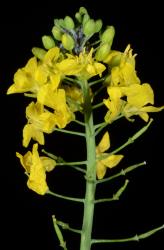- Taxon
- Gallery
Annual or biennial herb with lax rosette. Stems erect or ascending, becoming subwoody below, glabrous, to 1.5 m tall. Lower lvs petiolate, lyrate-pinnatifid with 1–3 pairs of lateral lobes, glaucous, bristly, especially on veins, often ciliate, 10–30 × 5–15 cm. Upper lvs glaucous, becoming entire, sessile, amplexicaul, glabrous, narrow-triangular, entire or toothed, 2–10 × 1–2 cm. Racemes to 40 cm long; open fls slightly below level of buds. Sepals erecto-patent, (4)–5–7 × 1–2 mm. Petals bright to pale yellow, 10–12 × (4)–5–6 mm. Lateral stamens spreading. Silique terete, glabrous, narrowly oblong, slightly constricted between seeds, (50)–60–80 × 2–5 mm; gynophore 0; valves with pronounced median and weak lateral veins; beak tapering, seedless, 8–15 mm long. Seeds dark brown to blue-black, 1.5–2.5 mm diam.
[From: Webb et al. (1988) Flora of New Zealand. Volume 4.]
| Category | Number |
|---|---|
| Exotic: Fully Naturalised | 1 |
| Exotic: Casual | 1 |
| Total | 2 |
Flowering: (Sep.)–Oct.–Dec.–(Apr.); Fruiting: (Sep.)–Oct.–Dec.–(Apr.)




